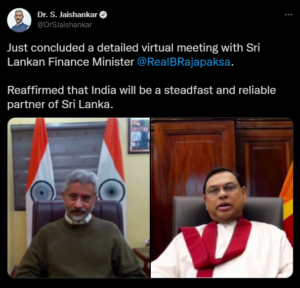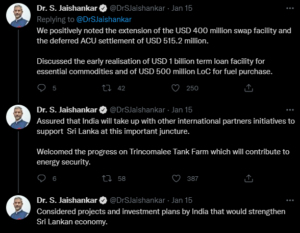by Inoka Perera 23 January 2022
On the verge of bankruptcy, Sri Lanka’s financial and humanitarian crisis seems to have escalated to unprecedented heights with foreign reserves down to around $1.6 billion, barely enough for a few weeks of imports. Its foreign debt obligations have exceeded to $7 billion in 2022, including repayment of bonds worth $500 million in January and $1 billion in July.
Amidst this chaos, the virtual meeting with the External Affairs Minister S. Jaishankar and Sri Lanka’s Finance Minister Basil Rajapaksa assured India’s support to Sri Lanka “in all possible ways for overcoming the economic and other challenges posed by COVID-19 pandemic” at a significant and timely need of the hour. This was followed by an expected package from India — a $1 billion credit line for essential food and medicine — that follows a 10 billion yuan ($1.5 billion) swap with the People’s Bank of China in late December.
Source: Twitter
One must however not forget that China has already convinced itself to be Sri Lanka’s primary donor by offering money for a number of high-profile construction and infrastructure projects such as and not limited to the Colombo Port city, the Hambantota harbor in the south and the Mattala airport. The aim of these massive projects is to one day strengthen Sri Lanka’s strategic position in the global world stage while also allowing China to develop its ambitious project of the Belt and Road Initiative. At the moment however Sri Lanka is struggling with a declining economy, increasingly high debts for which Colombo has requested China’s help for a restructure. China has so far ignored this request.
This may be predicted as one of the key reasons why the state government in Colombo believe it is high time to diversify their regional foreign interests.
Re-entering of India
After 24 years of failed dialogue, the Rajapaksa government was finally able to clear the proposal for India and Sri Lanka to jointly develop the Trincomalee oil tank project in eastern Sri Lanka which was first brought up during the I987 Indo-Sri Lanka Accord discussions between Rajiv Gandhi and J.R. Jayewardene.
According to Sri Lanka’s Energy Minister, the Indian Oil Corporation subsidiary, Lanka IOC would run the 14 oil storage tanks it currently operates for 50 years, while CPC would run 24 tanks. Trinco Petroleum Terminal Pvt. Ltd, set up by the CPC for the project, would develop the remaining 61 tanks in a joint venture where 51% stakes will be held by CPC and 49% by Lanka IOC. This joint venture is scheduled to last for 50 years.
Source: Twitter
Additionally, following discussions with the Indian External Affairs Minister, India has extended its support worth over $900 million and about $ 1.5 billion for both food and fuel. Although this may offer a short-term relief for Colombo, the two ministers have discussed extending the Indian credit facility of $ 1 billion for importing food, essential items, and medicine in addition to $500 million for importing fuel from India in the long term.
Reaffirming India to be a longstanding steadfast and reliable partner, the Sri Lankan Finance Minister Basil Rajapaksa has further welcomed Indian investments in important spheres including ports, infrastructure, energy, renewable energy, power and manufacturing and assured that a conducive environment will be provided to encourage such investments.
On the other hand however, Wang Yi’s visit hardly helped brighten things up for Sri Lanka. While requests to restructure debts were further ignored — Sri Lanka has already run up an external debt of more than $45 billion — about 60% per cent of its nominal GDP (2020) compared to India’s around 20% and Pakistan’s 40%. Sri Lanka owes at least $8 billion to China alone. China nevertheless sends a shipment of sugar, slyly proposing to sign a free trade agreement (FTA) with Colombo, which Colombo has ignored.
Thus, it is fair to say that foreign policy relations and dynamics between Sri Lanka, India and China have encountered swift changes in the dawn of the New Year. Indeed, on the regional front, India remains closely conscious of the Chinese presence on the Line of Actual Control (LAC) in the Himalayas with no signs of retrieving anytime soon.
In the meantime, China has been trying to dominate its influence in the Indian Ocean, particularly after the Rajapaksa government handing over the East Container Terminal of the Colombo port to the Chinese — union workers had strongly opposed the India-Japan-Sri Lanka venture that had sought to manage it.
Notwithstanding, India’s Adani Group was successful in sealing a deal with the state-owned Sri Lanka Ports Authority (SLPA) to develop and run the strategic Colombo Port’s Western Container Terminal.
Chinese Money in Vain
When the pandemic began two years ago, PM Mahinda Rajapaksa chanted prayers on behalf of the Chinese people and China provided a large number of COVID-19 vaccines and anti-pandemic supplies to Sri Lanka. Today, the people have started questioning about the “Chinese debt trap” and if India, being the poorer neighbor can actually offer more sustainable alternatives.
It is now a likely assumption that the once favourite regional partnership with the Chinese, developing the Hambantota port and the Mattala airport during Mahinda Rajapaksa’s government, may actually be finally fading (when Sri Lanka failed to return its annual EMI on the Chinese loan, it was obliged to lease the port over to the state-owned China Merchants agency for 99 years).
Colombo may have also realized by now that a similar situation has transpired with the Colombo Port city. Sri Lanka needed the China Harbour Engineering Company (CHEC) to invest $1.4bn in order to reclaim 665 acres. In return however, the firm has been given 43% of it on a 99-year lease.
The pushback
India’s response to the Sri Lankan financial crisis with such fervor is evidence of the mutual understanding between the Rajapaksa and the Narendra Modi government owing to which.
Nevertheless Colombo will certainly evaluate its future investments with regional partners and the foreign policy implications they may have while in the meantime, Sri Lanka seems to have realized the growing amounts of debts over China piling up each day especially with regard to how certain smaller economies such as the Republic of Djibouti, Laos, Zambia, and Kyrgyzstan have debts to China amounting to 20% of their GDP.
Have the Rajapaksa government finally realized the long game that the Chinese are playing and the crisis it has put the country into? Was there a diplomatic intervention during Wang Yi’s visit? Is that why China refused to restructure Sri Lanka’s debt?
Whatever the reality may turn out to be, there is an evident hint of a pushback against China that has set in motion following India’s response to Sri Lanka’s economic crisis.


